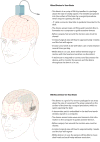Assessment of brain-machine interfaces from the perspective of people with paralysis
- PMID: 26169880
- PMCID: PMC4761228
- DOI: 10.1088/1741-2560/12/4/043002
Assessment of brain-machine interfaces from the perspective of people with paralysis
Abstract
Objective: One of the main goals of brain-machine interface (BMI) research is to restore function to people with paralysis. Currently, multiple BMI design features are being investigated, based on various input modalities (externally applied and surgically implantable sensors) and output modalities (e.g. control of computer systems, prosthetic arms, and functional electrical stimulation systems). While these technologies may eventually provide some level of benefit, they each carry associated burdens for end-users. We sought to assess the attitudes of people with paralysis toward using various technologies to achieve particular benefits, given the burdens currently associated with the use of each system.
Approach: We designed and distributed a technology survey to determine the level of benefit necessary for people with tetraplegia due to spinal cord injury to consider using different technologies, given the burdens currently associated with them. The survey queried user preferences for 8 BMI technologies including electroencephalography, electrocorticography, and intracortical microelectrode arrays, as well as a commercially available eye tracking system for comparison. Participants used a 5-point scale to rate their likelihood to adopt these technologies for 13 potential control capabilities.
Main results: Survey respondents were most likely to adopt BMI technology to restore some of their natural upper extremity function, including restoration of hand grasp and/or some degree of natural arm movement. High speed typing and control of a fast robot arm were also of interest to this population. Surgically implanted wireless technologies were twice as 'likely' to be adopted as their wired equivalents.
Significance: Assessing end-user preferences is an essential prerequisite to the design and implementation of any assistive technology. The results of this survey suggest that people with tetraplegia would adopt an unobtrusive, autonomous BMI system for both restoration of upper extremity function and control of external devices such as communication interfaces.
Figures







References
-
- Anderson KD. Targeting Recovery: Priorities of the Spinal Cord-Injured Population. Journal of Neurotrauma. 2004;21:1371–1383. 2004. - PubMed
-
- Brown-Triolo DL, Roach MJ, Nelson K, Triolo RJ. Consumer perspectives on mobility: Implications for neuroprosthesis design. Journal of Rehabilitation Research and Development. 2002;39:659–670. - PubMed
Publication types
MeSH terms
Grants and funding
LinkOut - more resources
Full Text Sources
Other Literature Sources
